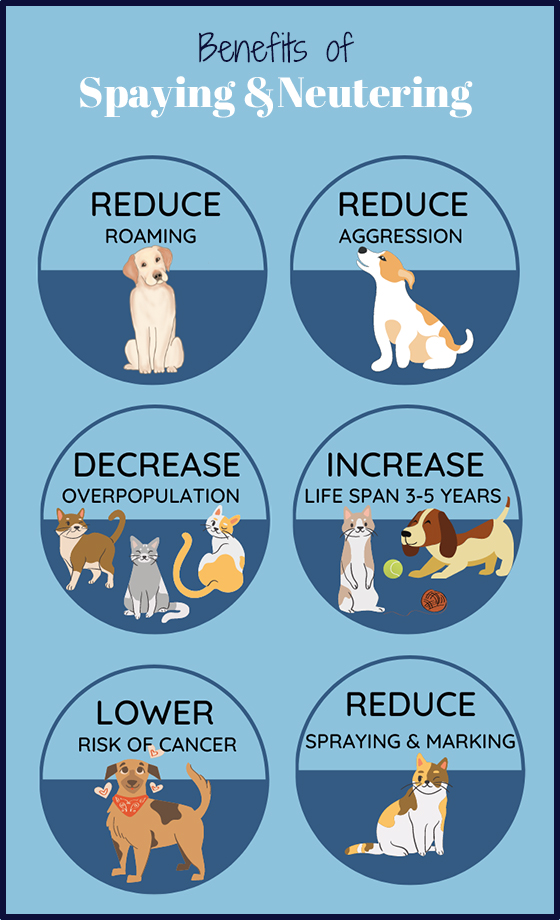Understanding the Benefits of Spaying Your Pet: Health, Behavior, and More
Introduction:
The decision to spay your pet is a significant one that comes with numerous benefits. In this article, we’ll delve into the advantages of spaying your pet, including improved health, better behavior, and the positive impact on your community.
Health Benefits
Improved Health and Longevity
Spaying your pet, whether it’s a cat or a dog, can have a profound impact on their overall health and longevity. Research has shown that spayed pets tend to live longer, healthier lives. The procedure helps reduce the risk of several health issues that can plague unspayed pets. Some of the key health benefits of spaying include:
Lower Risk of Reproductive Health Problems:
Female pets are at risk of developing pyometra, a life-threatening infection of the uterus. Spaying eliminates this risk entirely, sparing your pet from potential suffering and expensive medical bills.
Decreased Risk of Mammary Tumors:
Female pets are also susceptible to mammary tumors, which can be malignant. Spaying before their first heat cycle significantly reduces the risk of these tumors.

Behavioral Benefits
Reduced Aggression and Roaming
One of the notable behavioral benefits of spaying your pet is the reduction in aggression and the tendency to roam. This benefit is particularly relevant for male pets, but it can also apply to females. Here’s how spaying can positively impact your pet’s behavior:
Calmer Demeanor:
Spayed pets tend to exhibit a calmer and less aggressive demeanor. This can lead to a more peaceful coexistence with other pets in your household.
Decreased Roaming:
Unspayed males often have a strong instinct to roam in search of a mate. This can put them at risk of accidents, getting lost, or engaging in territorial disputes. Spaying helps reduce this urge to roam, making them safer and more content staying close to home.
Community Impact
Contribution to Animal Welfare
Spaying your pet goes beyond individual benefits; it contributes to the larger cause of animal welfare. By reducing the number of unplanned litters, you are actively participating in the responsible management of pet populations. This, in turn, alleviates the strain on animal shelters and resources.
Legal and Ethical Considerations
It’s important to be aware of any local laws and ethical considerations related to pet spaying. Some areas may have regulations in place to control pet populations, and it’s crucial to comply with these rules as a responsible pet owner. Being informed about the legal and ethical aspects of spaying helps you make well-informed decisions for your pet and your community.
The Spaying Process
What to Expect During the Procedure
Understanding what to expect during the spaying procedure is essential for pet owners. While the process may vary slightly depending on the type of pet and the veterinarian, here are some general insights into the spaying procedure:
Preoperative Evaluation:
Before the surgery, your veterinarian will conduct a thorough examination to ensure your pet is in good health and can safely undergo the procedure.
Anesthesia and Monitoring:
Pets are placed under anesthesia to ensure they are comfortable and pain-free during the procedure. They are closely monitored throughout the surgery.
Myths and Misconceptions
Addressing Common Misconceptions
There are several myths and misconceptions surrounding spaying and neutering. It’s crucial to separate fact from fiction. Here are some common misconceptions:
Spaying Will Make My Pet Fat:
Spaying itself doesn’t cause weight gain. Proper diet and exercise are essential for maintaining a healthy weight.
My Pet Should Have One Litter Before Spaying:
This is a misconception. Allowing your pet to have a litter is not necessary and can contribute to the overpopulation problem.
FAQs About Pet Spaying
Q: What is spaying, and how does it differ from neutering?
A: Spaying is the surgical removal of a female pet’s ovaries and, in some cases, the uterus. Neutering, on the other hand, is the removal of a male pet’s testicles. Both procedures are aimed at preventing reproduction and offer health and behavior benefits.
Q: What is the ideal age to spay my pet?
A: The ideal age for spaying or neutering can vary by species and breed. Generally, it’s recommended for kittens and puppies between 8 to 16 weeks of age. Consult with your veterinarian for the best timing for your specific pet.
Q: Does spaying my pet change their behavior?
A: Spaying can influence behavior, such as reducing aggression and territorial tendencies, especially in males. It doesn’t alter their essential personality but can lead to calmer and less disruptive behavior.
Q: Will spaying make my pet gain weight?
A: Spaying itself doesn’t cause weight gain. However, spayed pets may have a slightly lower metabolic rate, so it’s essential to monitor their diet and exercise to prevent weight gain.
Q: Is it necessary for my pet to have one litter before spaying?
A: No, it’s not necessary for your pet to have a litter before spaying. In fact, allowing your pet to have a litter contributes to the overpopulation problem and doesn’t provide any health benefits.
Q: Can spaying prevent certain health issues in female pets?
A: Yes, spaying can significantly reduce the risk of health problems in females, such as pyometra (uterine infection) and mammary tumors. It is a proactive measure to safeguard your pet’s well-being.
Q: Does spaying my male pet have any health benefits?
A: Yes, spaying male pets can prevent testicular cancer and reduce the risk of certain behavioral issues like marking and territorial aggression.
Q: Is spaying an expensive procedure?
A: The cost of spaying is a one-time expense and is usually less expensive than potential veterinary bills for reproductive health issues or complications. It’s a cost-effective investment in your pet’s long-term health.
Q: What are the legal and ethical considerations for pet spaying?
A: Some areas have legal requirements regarding pet spaying or neutering, especially for outdoor pets. It’s important to be aware of local regulations and ethical responsibilities to promote responsible pet ownership.
Q: How can spaying my pet help with animal overpopulation?
A: Spaying your pet is a responsible step in controlling pet overpopulation. By preventing unplanned litters, you are actively contributing to reducing the number of homeless and abandoned animals, ultimately benefiting your community and animal welfare.
Conclusion
In conclusion, spaying your pet offers a multitude of benefits that positively impact their health, behavior, and the broader community. It’s a responsible choice that can lead to a longer, happier, and healthier life for your beloved companion. By addressing common myths and misconceptions and understanding the spaying process, you’re better equipped to make an informed decision for your pet’s well-being. Spaying is not only a personal choice but also a collective effort to manage pet populations and promote animal welfare. Make the responsible choice, and consider spaying your pet today.




